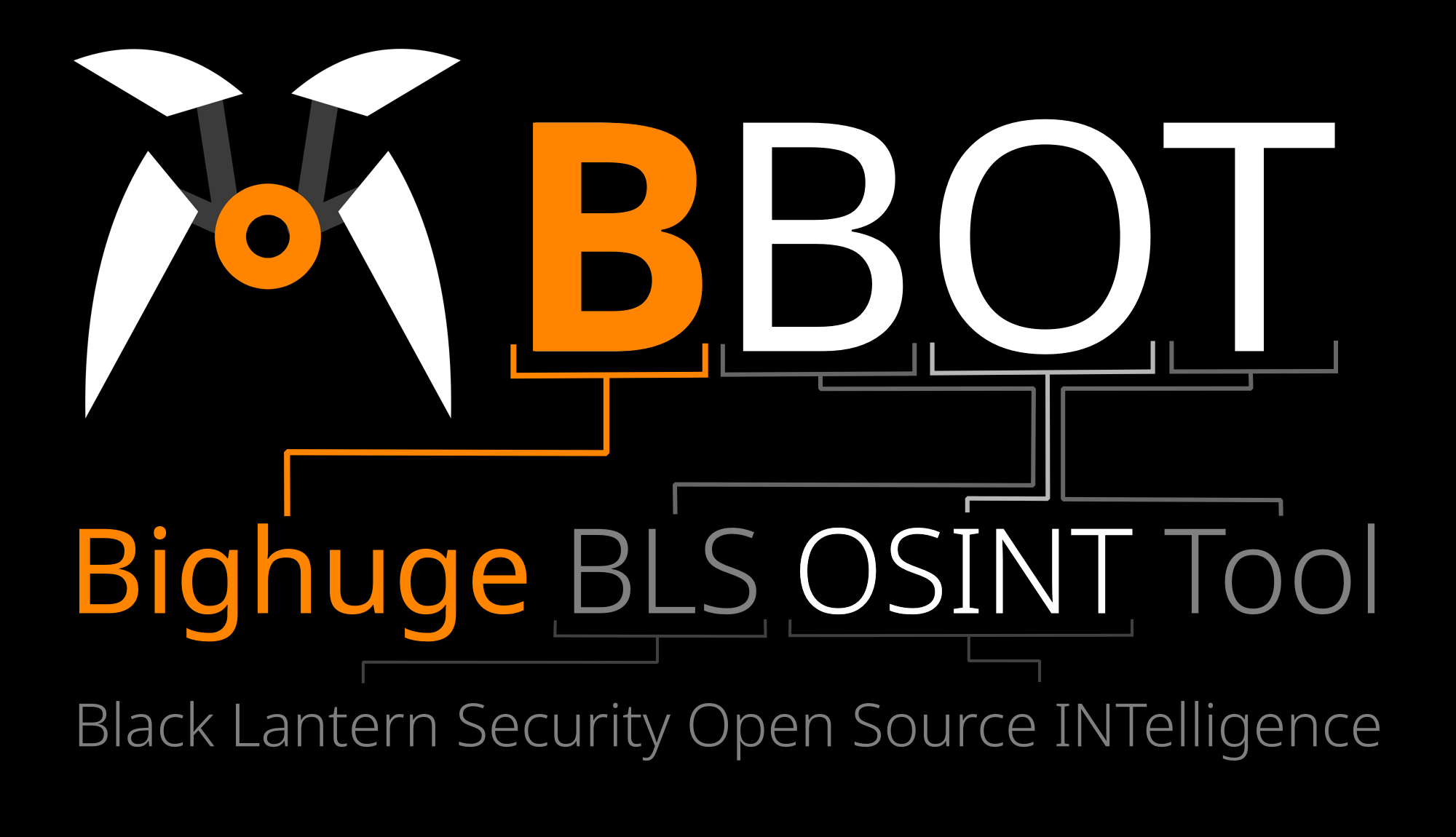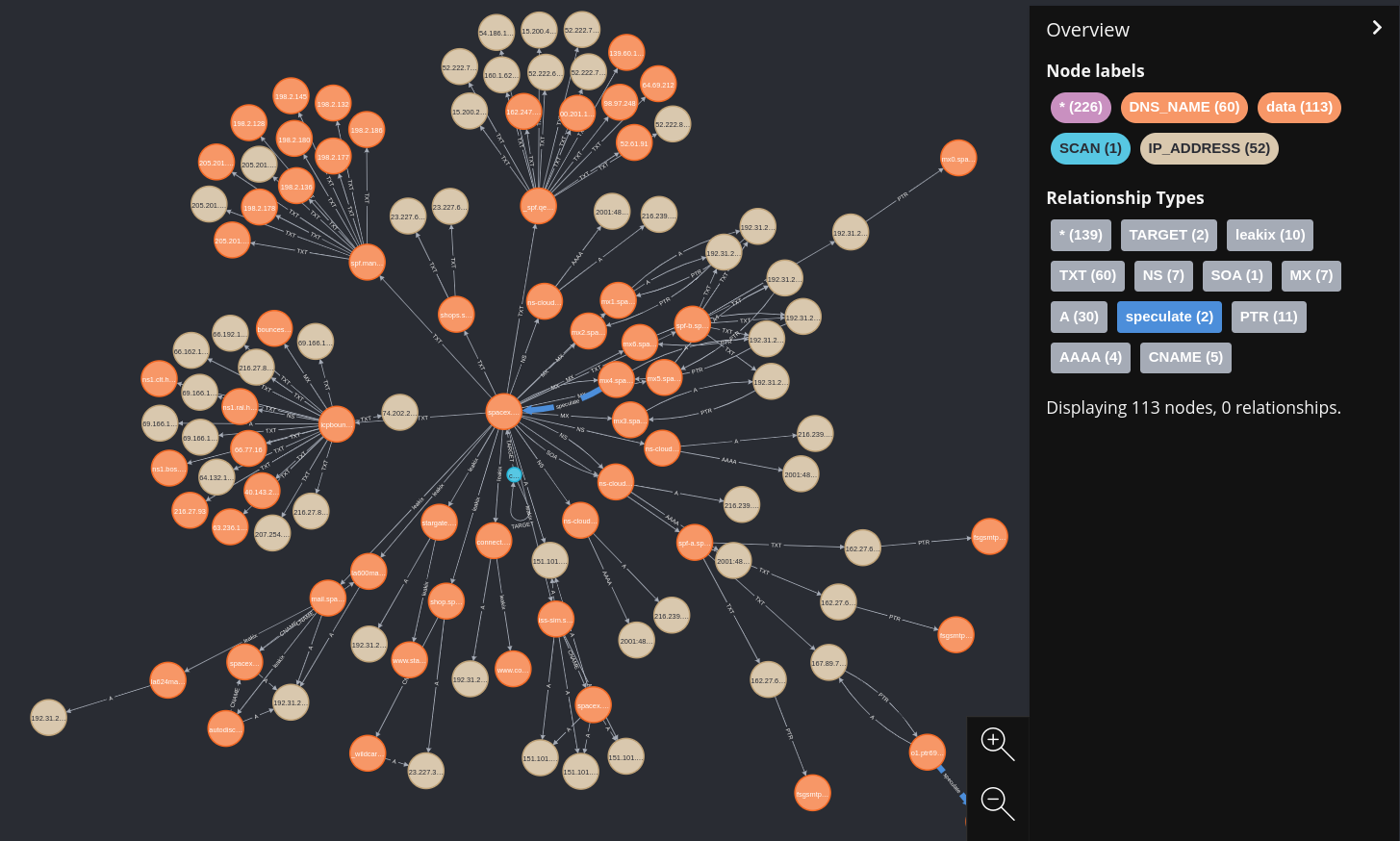OSINT automation for hackers.
Project description
BEE·bot
OSINT automation for hackers.
BBOT is a recursive, modular OSINT framework written in Python.
It is capable of executing the entire OSINT process in a single command, including subdomain enumeration, port scanning, web screenshots (with its gowitness module), vulnerability scanning (with nuclei), and much more.
BBOT currently has over 50 modules and counting.
Installation (pip)
pip install bbot
bbot --help
Prerequisites:
- Linux or WSL
- Python 3.9 or newer
Installation (docker)
git clone https://github.com/blacklanternsecurity/bbot && cd bbot
docker build . -t bbot
docker run bbot --help
# note: alternatively there is a helper script that will automatically map docker volumes to persist your BBOT scan data:
./bbot-docker.sh --help
If you need help with installation, please refer to the wiki.
Scanning with BBOT
Note: the httpx module is recommended in most scans because it is used by BBOT to visit webpages.
Examples
# list modules
bbot -l
# subdomain enumeration
bbot --flags subdomain-enum --modules httpx --targets evilcorp.com
# passive modules only
bbot --flags passive --targets evilcorp.com
# web screenshots with gowitness
bbot -m naabu httpx gowitness --name my_scan --output-dir . -t subdomains.txt
# web scan
bbot -f web-basic -t www.evilcorp.com
# web spider (search for emails, etc.)
bbot -m httpx -c web_spider_distance=2 web_spider_depth=2 -t www.evilcorp.com
# everything at once because yes
bbot -f subdomain-enum web-basic -m naabu gowitness -c web_spider_distance=2 web_spider_depth=2 -t evilcorp.com
Visit the wiki for more tips and tricks.
Using BBOT as a Python library
from bbot.scanner import Scanner
scan = Scanner("evilcorp.com", "1.2.3.0/24", modules=["naabu"], output_modules=["json"])
scan.start()
Output
BBOT can output to TXT, JSON, CSV, Neo4j, and more with --output-module. You can output to multiple formats simultaneously.
# tee to a file
bbot -f subdomain-enum -t evilcorp.com | tee evilcorp.txt
# output to JSON
bbot --output-module json -f subdomain-enum -t evilcorp.com | jq
# output to CSV, TXT, and JSON, in current directory
bbot -o . --output-module human csv json -f subdomain-enum -t evilcorp.com
For every scan, BBOT generates a unique and mildly-entertaining name like fuzzy_gandalf. Output for that scan, including the word cloud and any gowitness screenshots, etc., are saved to a folder by that name in ~/.bbot/scans. The most recent 20 scans are kept, and older ones are removed. You can change the location of BBOT's output with --output, and you can also pick a custom scan name with --name.
If you reuse a scan name, it will append to its original output files and leverage the previous word cloud.
Neo4j
Neo4j is the funnest (and prettiest) way to view and interact with BBOT data.
- You can get Neo4j up and running with a single docker command:
docker run -p 7687:7687 -p 7474:7474 --env NEO4J_AUTH=neo4j/bbotislife neo4j
- After that, run bbot with
--output-modules neo4j
bbot -f subdomain-enum -t evilcorp.com --output-modules human neo4j
- Browse data at http://localhost:7474
Usage
$ bbot --help
usage: bbot [-h] [-t TARGET [TARGET ...]] [-w WHITELIST [WHITELIST ...]] [-b BLACKLIST [BLACKLIST ...]] [-s] [-n SCAN_NAME] [-m MODULE [MODULE ...]] [-l] [-em MODULE [MODULE ...]] [-f FLAG [FLAG ...]]
[-rf FLAG [FLAG ...]] [-ef FLAG [FLAG ...]] [-om MODULE [MODULE ...]] [-o DIR] [-c [CONFIG ...]] [--allow-deadly] [-v] [-d] [--force] [-y] [--dry-run] [--current-config] [--save-wordcloud FILE]
[--load-wordcloud FILE] [--no-deps | --force-deps | --retry-deps | --ignore-failed-deps] [-a]
Bighuge BLS OSINT Tool
options:
-h, --help show this help message and exit
-n SCAN_NAME, --name SCAN_NAME
Name of scan (default: random)
-m MODULE [MODULE ...], --modules MODULE [MODULE ...]
Modules to enable. Choices: affiliates,asn,aspnet_viewstate,azure_tenant,binaryedge,blind_ssrf,bypass403,c99,censys,certspotter,cookie_brute,crobat,crt,dnscommonsrv,dnsdumpster,dnszonetransfer,emailformat,ffuf,ffuf_shortnames,generic_ssrf,getparam_brute,github,gowitness,hackertarget,header_brute,host_header,httpx,hunt,hunterio,iis_shortnames,ipneighbor,leakix,massdns,naabu,ntlm,nuclei,passivetotal,pgp,securitytrails,shodan_dns,skymem,smuggler,sslcert,sublist3r,telerik,threatminer,urlscan,viewdns,wappalyzer,wayback,zoomeye
-l, --list-modules List available modules.
-em MODULE [MODULE ...], --exclude-modules MODULE [MODULE ...]
Exclude these modules.
-f FLAG [FLAG ...], --flags FLAG [FLAG ...]
Enable modules by flag. Choices: active,aggressive,brute-force,deadly,passive,portscan,report,safe,slow,subdomain-enum,web
-rf FLAG [FLAG ...], --require-flags FLAG [FLAG ...]
Disable modules that don't have these flags (e.g. --require-flags passive)
-ef FLAG [FLAG ...], --exclude-flags FLAG [FLAG ...]
Disable modules with these flags. (e.g. --exclude-flags brute-force)
-om MODULE [MODULE ...], --output-modules MODULE [MODULE ...]
Output module(s). Choices: csv,http,human,json,neo4j,websocket
-o DIR, --output-dir DIR
-c [CONFIG ...], --config [CONFIG ...]
custom config file, or configuration options in key=value format: 'modules.shodan.api_key=1234'
--allow-deadly Enable running modules tagged as "deadly"
-v, --verbose Be more verbose
-d, --debug Enable debugging
--force Run scan even if module setups fail
-y, --yes Skip scan confirmation prompt
--dry-run Abort before executing scan
--current-config Show current config in YAML format
Target:
-t TARGET [TARGET ...], --targets TARGET [TARGET ...]
Targets to seed the scan
-w WHITELIST [WHITELIST ...], --whitelist WHITELIST [WHITELIST ...]
What's considered in-scope (by default it's the same as --targets)
-b BLACKLIST [BLACKLIST ...], --blacklist BLACKLIST [BLACKLIST ...]
Don't touch these things
-s, --strict-scope Don't consider subdomains of target/whitelist to be in-scope
Word cloud:
Save/load wordlist of common words gathered during a scan
--save-wordcloud FILE
Output wordcloud to custom file when the scan completes
--load-wordcloud FILE
Load wordcloud from a custom file
Module dependencies:
Control how modules install their dependencies
--no-deps Don't install module dependencies
--force-deps Force install all module dependencies
--retry-deps Try again to install failed module dependencies
--ignore-failed-deps Run modules even if they have failed dependencies
Agent:
Report back to a central server
-a, --agent-mode Start in agent mode
BBOT Config
BBOT loads its config from these places in the following order:
~/.config/bbot/defaults.yml~/.config/bbot/bbot.yml<-- Use this one as your main config~/.config/bbot/secrets.yml<-- Use this one for sensitive stuff like API keys- command line (via
--config)
These config files will be automatically created for you when you first run BBOT.
Command-line arguments take precedence over all others. You can give BBOT a custom config file with --config myconf.yml, or individual arguments like this: --config http_proxy=http://127.0.0.1:8080 modules.shodan_dns.api_key=1234. To display the full and current BBOT config, including any command-line arguments, use bbot --current-config.
For explanations of config options, see defaults.yml or the wiki
Modules
Note: You can find more fun and interesting modules at the Module Playground. For instructions on how to install these other modules, see the wiki.
| Module | Needs API Key | Description | Flags | Produced Events |
|---|---|---|---|---|
| aspnet_viewstate | Parse web pages for viewstates and check them against blacklist3r | active,safe,web | VULNERABILITY | |
| bypass403 | Check 403 pages for common bypasses | active,aggressive,web | FINDING | |
| cookie_brute | Check for common HTTP cookie parameters | active,aggressive,brute-force,slow,web | FINDING | |
| dnszonetransfer | Attempt DNS zone transfers | active,safe,subdomain-enum | DNS_NAME | |
| ffuf | A fast web fuzzer written in Go | active,aggressive,brute-force,deadly,web | URL | |
| ffuf_shortnames | Use ffuf in combination IIS shortnames | active,aggressive,brute-force,web | URL | |
| generic_ssrf | Check for generic SSRFs | active,aggressive,web | VULNERABILITY | |
| getparam_brute | Check for common HTTP GET parameters | active,aggressive,brute-force,slow,web | FINDING | |
| gowitness | Take screenshots of webpages | active,safe,web | SCREENSHOT | |
| header_brute | Check for common HTTP header parameters | active,aggressive,brute-force,slow,web | FINDING | |
| host_header | Try common HTTP Host header spoofing techniques | active,aggressive,web | FINDING | |
| httpx | Visit webpages. Many other modules rely on httpx | active,safe,web | HTTP_RESPONSE,URL | |
| hunt | Watch for commonly-exploitable HTTP parameters | active,safe,web | FINDING | |
| iis_shortnames | Check for IIS shortname vulnerability | active,safe | URL_HINT | |
| naabu | Execute port scans with naabu | active,aggressive,portscan | OPEN_TCP_PORT | |
| ntlm | Watch for HTTP endpoints that support NTLM authentication | active,safe,web | DNS_NAME,FINDING | |
| nuclei | Fast and customisable vulnerability scanner | active,aggressive,deadly,web | VULNERABILITY | |
| smuggler | Check for HTTP smuggling | active,aggressive,brute-force,slow,web | FINDING | |
| sslcert | Visit open ports and retrieve SSL certificates | active,email-enum,safe,subdomain-enum | DNS_NAME,EMAIL_ADDRESS | |
| telerik | Scan for critical Telerik vulnerabilities | active,aggressive,web | FINDING,VULNERABILITY | |
| vhost | Fuzz for virtual hosts | active,aggressive,brute-force,deadly,slow,web | DNS_NAME,VHOST | |
| wappalyzer | Extract technologies from web responses | active,safe,web | TECHNOLOGY | |
| affiliates | Summarize affiliate domains at the end of a scan | passive,report,safe | ||
| asn | Query bgpview.io for ASNs | passive,report,safe,subdomain-enum | ASN | |
| azure_tenant | Query Azure for tenant sister domains | passive,safe,subdomain-enum | DNS_NAME | |
| binaryedge | X | Query the BinaryEdge API | passive,safe,subdomain-enum | DNS_NAME |
| builtwith | X | Query Builtwith.com for subdomains | passive,safe,subdomain-enum | DNS_NAME |
| c99 | X | Query the C99 API for subdomains | passive,safe,subdomain-enum | DNS_NAME |
| censys | X | Query the Censys API | email-enum,passive,safe,subdomain-enum | DNS_NAME,EMAIL_ADDRESS,IP_ADDRESS,OPEN_PORT,PROTOCOL |
| certspotter | Query Certspotter's API for subdomains | passive,safe,subdomain-enum | DNS_NAME | |
| crobat | Query Project Crobat for subdomains | passive,safe,subdomain-enum | DNS_NAME | |
| crt | Query crt.sh (certificate transparency) for subdomains | passive,safe,subdomain-enum | DNS_NAME | |
| dnscommonsrv | Check for common SRV records | passive,safe,subdomain-enum | DNS_NAME | |
| dnsdumpster | Query dnsdumpster for subdomains | passive,safe,subdomain-enum | DNS_NAME | |
| emailformat | Query email-format.com for email addresses | email-enum,passive,safe | EMAIL_ADDRESS | |
| fullhunt | X | Query the fullhunt.io API for subdomains | passive,safe,subdomain-enum | DNS_NAME |
| github | X | Query Github's API for related repositories | passive,safe,subdomain-enum | URL_UNVERIFIED |
| hackertarget | Query the hackertarget.com API for subdomains | passive,safe,subdomain-enum | DNS_NAME | |
| hunterio | X | Query hunter.io for emails | email-enum,passive,safe,subdomain-enum | DNS_NAME,EMAIL_ADDRESS,URL_UNVERIFIED |
| ipneighbor | Look beside IPs in their surrounding subnet | aggressive,passive,subdomain-enum | IP_ADDRESS | |
| leakix | Query leakix.net for subdomains | passive,safe,subdomain-enum | DNS_NAME | |
| massdns | Brute-force subdomains with massdns (highly effective) | aggressive,brute-force,passive,slow,subdomain-enum | DNS_NAME | |
| otx | Query otx.alienvault.com for subdomains | passive,safe,subdomain-enum | DNS_NAME | |
| passivetotal | X | Query the PassiveTotal API for subdomains | passive,safe,subdomain-enum | DNS_NAME |
| pgp | Query common PGP servers for email addresses | email-enum,passive,safe | EMAIL_ADDRESS | |
| rapiddns | Query rapiddns.io for subdomains | passive,safe,subdomain-enum | DNS_NAME | |
| securitytrails | X | Query the SecurityTrails API for subdomains | passive,safe,subdomain-enum | DNS_NAME |
| shodan_dns | X | Query Shodan for subdomains | passive,safe,subdomain-enum | DNS_NAME |
| skymem | Query skymem.info for email addresses | email-enum,passive,safe | EMAIL_ADDRESS | |
| sublist3r | Query sublist3r's API for subdomains | passive,safe,subdomain-enum | DNS_NAME | |
| threatminer | Query threatminer's API for subdomains | passive,safe,subdomain-enum | DNS_NAME | |
| urlscan | Query urlscan.io for subdomains | passive,safe,subdomain-enum | DNS_NAME,URL_UNVERIFIED | |
| viewdns | Query viewdns.info's reverse whois for related domains | passive,safe,subdomain-enum | DNS_NAME | |
| wayback | Query archive.org's API for subdomains | passive,safe,subdomain-enum | DNS_NAME,URL_UNVERIFIED | |
| zoomeye | X | Query ZoomEye's API for subdomains | passive,safe,subdomain-enum | DNS_NAME |
Project details
Release history Release notifications | RSS feed
Download files
Download the file for your platform. If you're not sure which to choose, learn more about installing packages.



















